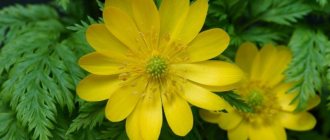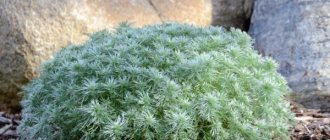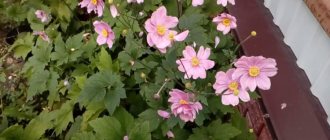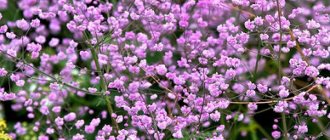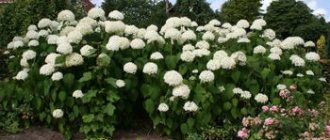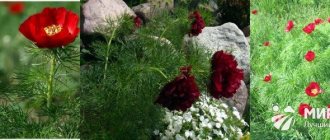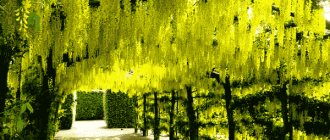6001
In parks, near roads, and in garden plots, turf is often planted. In the central regions and in the north, white Elegantissima and Siberian derain are in demand, which are more adapted to cold climates. Even a novice gardener can grow and beautifully prune an unpretentious shrub if you study the proposed instructions.
Neighborhood with hydrangea
Description of the Sibirika tree
After reading the characteristics and descriptions of White Siberian Derain, no gardener remains indifferent. Chic, bright ornamental bushes look great at any time of the year.
The leaves of the plant are quite wide, slightly pointed at the ends. The color of the Sibirika tree is rich green; closer to autumn, the bushes acquire a crimson hue.
The flowers of White Siberian Derain are small, cream-colored, and collected in lush buds. The flowering period of the plant is May-June, in the fall - September-October.
The berries are small, round in shape. The color of the fruit is white; in autumn the berries acquire a slightly blue tint.
The root of the perennial is flat, thread-like. The plant propagates well by cuttings and by dividing the bush.
The perennial can grow on almost any soil.
Advice! White Siberian dogwood grows very well in moist soils.
Deren Sibirika Variegata
White dogwood in Siberia has more than 50 species. Most varieties of perennials are used for decoration in landscape design. One of the most popular varieties is the white dogwood Sibirica Variegata. This variety is also fast-growing; it can grow up to 3 m in height.
Derain Sibirika Variegata has a wide spreading crown, the diameter of which is more than 1.5 m. This variety is significantly different from other types of perennials: the color of the bark of Derain Sibirika Variegata is brighter, often the bushes are bright red.
Attention! The younger the perennial bush, the brighter the color the plant will have.
Bushes that are more than 10 years old may acquire a grayish tint. The leaves of the plant are ovoid, slightly folded. Flowering period is May-June.
Often the plant can bloom again in September. If the perennial is provided with proper care, the bushes will grow in one place for more than 20 years.
It is worth noting that from the description of the Sibirika Variegata derain is resistant to low temperatures, tolerates a lack of moisture and lack of sunlight.
Attention! The plant can grow in any conditions. The crop is often planted for landscaping parks and streets.
The perennial is planted both alone and in group plantings. Such bushes look attractive in winter and have a bright, rich color.
In the photo you can see how white Siberian turf looks on the site.
White dogwood Pearl of Siberia
White dogwood Pearl of Siberia is also a fast-growing perennial. The plant has dark green leaves and burgundy stems. During the flowering period, the bushes are covered with small white flowers, which are collected in small buds.
The period of active flowering is spring and autumn. White dogwood Sibirian Pearls tolerates sudden changes in temperature well and requires minimal care.
What does derain look like?
White dogwood (also known as white telecrania) is a deciduous, highly branched shrub, capable of reaching a height of up to 2.5 meters, with the following characteristic features:
- straight flexible shiny branches of an unusual bright red color, and perhaps all shades of this color are represented in color: from coral and bloody to brown-red. The color saturation depends on the time of year and the age of the plant: the younger it is, the brighter the color. Another feature is that this color usually appears after the turf begins to be systematically trimmed. With age, the branches bend in an arched manner, and the color may acquire a grayish tint. Also in gardening there are varieties with yellow bark.
- spreading wide crown with a diameter of about 2 meters.
- slightly folded opposite leaves from 2 to 10 cm long and up to 7 cm wide with prominent arcuate veins and spots and stripes in the center of the leaf. The leaf blades are most often oval, less often ovoid, short pubescent, dark green above, bluish below.
- sparse flowers in the form of dense shields-inflorescences of a creamy-greenish color with a diameter of 3-5 cm.
- densely pubescent pedicels of grayish or reddish color.
- a calyx with broadly triangular teeth, and a corolla with four white petals 4-5 mm.
- the fruit is a small round berry-shaped drupe formed after flowering in place of the flowers. When ripe, it changes its color from bluish blue to bluish white. Has a slight waxy coating.
Telekrania differs from the American pig:
- shoots (in the first they bend strongly towards the ground and often take root at the top).
- fruit color (milky white versus bluish-blueish white).
- the shape of the bones (in pork it is almost spherical).
There are two forms of Sibirika: with variegated leaves and with leaves bordered by a creamy white stripe. In autumn they change color to yellow, violet or purple. The plant blooms from May to June and is an excellent honey plant during this period.
Deren Sibirika in landscape design
White cornus alba Sibirica is regularly used for decoration in landscape design. The plant acquires its brightest colors in autumn and winter. The rich red shades of the stems leave no one indifferent. The plant can be planted in any area. Preference is given to planting in parks, gardens and dachas.
White derain looks beautiful in group planting near bodies of water. When planted alone, plants are used for landscaping and landscaping.
However, most often white Sibirika Variegata derain is used in landscape design as background bushes and protective fences near highways. The plant can withstand city conditions well and is not afraid of exhaust gases.
White Sibirika dogwood can be planted in any area, because the fiery red branches become a decoration of any garden or area on the cloudiest days.
Propagation by cuttings
Seed propagation of dera is a long and difficult process, therefore it is used extremely rarely. In view of this, propagation by cuttings is used for varieties Elengatissima, Sibirika and others.
Semi-lignified or lignified ones are used as cuttings for propagation. If there are a lot of cuttings, then they can be planted in cold greenhouses. If it’s not enough, then take separate containers; flower pots will do.
Propagation by cuttings is carried out in the spring.
Planted cuttings must be regularly watered and sprayed.
This propagation method allows you to obtain a large number of new plants.
Conservatory border at Bressingham Gardens, Norfolk, UK.
Planting and caring for derain in Siberia
Before you start planting a plant, you need to choose the right place and prepare the soil. The perennial grows well in places that are regularly illuminated by sunlight. A small shadow for the white Siberian tree in the form of tall plants will be an additional advantage - this way the bushes look more decorative.
Planting and caring for white Sibirika Variegata dogwood is carried out in a standard manner, with strict adherence to all rules.
Landing dates
White Siberian turf is planted in early spring, rarely in autumn. To do this, you need to prepare cuttings in the summer. The shoots are taken from an adult bush and planted in moist soil.
As soon as the cuttings take root, you can begin caring for them. Regular watering and fertilizing are the basic rules for good perennial growth.
Attention! For the winter, young shoots are covered. In spring, seedlings are planted in a new location.
Landing rules
To properly land, you must follow these rules:
- Feed the soil before planting seedlings.
- Dig a deep hole the size of a bush root.
- Place the seedling so that the neck of the root system is at soil level.
- Fill up the planting hole.
- Water.
2 weeks after planting, it will be possible to begin the main watering and fertilizing.
Watering and fertilizing
Bushes need to be watered regularly. In dry weather, watering is carried out once a week; in rainy weather, irrigation is stopped. For proper growth after moistening, it is important to mulch the soil with straw. This way, the root system will remain moist longer.
Important! Do not forget about loosening the soil after each irrigation of the bush.
It is also worth noting that perennials must be watered regularly. The appearance of the bush depends on the quantity and quality of watering. The most correct thing to do is to moisten the bushes at the root. Add 5-7 liters of water for each.
Fertilizing
The perennial needs regular feeding. Fertilizers are often applied in the spring. For this purpose, mineral and complex fertilizers are used. In the summer, humus or compost is added under the bushes.
Trimming
In order for the white Siberian dera bushes to have a decorative appearance, it is necessary to prune the shoots. Old and 3-year-old branches are subject to pruning. The procedure is carried out before flowering begins - in spring or late autumn.
It is also worth noting that if there are weak, leafy shoots on the bushes, they must be removed.
Preparing for winter
The Sibirika derain does not need any special preparatory measures. Only young plants need to be covered for the winter.
It is worth noting that in the autumn it is important to prune plants and apply mineral fertilizers. Closer to frost, if possible, you can cover the perennial root with fallen leaves.
Landing
The first condition that must be observed in order for the bush to take root and grow faster is to prepare the planting site well and choose the right planting material.
When purchasing “Sibirika” seedlings from a nursery, it is better to choose a 1–3-year-old plant: such seedlings acclimatize faster in a new place and take root. If the seedling is large, then before planting it in open ground, the roots of the bush need to be kept in water for several hours.
Planting white turf begins with digging a hole ranging from 30 cm to 0.5 meters in size - its size depends on the age of the crop and the degree of development of the roots. The root system of the bush is superficial, so there is no need to dig too deep holes.
We lay a layer of drainage on the bottom of the hole (turf does not like waterlogged soil) and sprinkle it with a nutritious soil mixture made by mixing humus and compost. After planting the bush, mulch is placed in the root circle area and watered.
Reproduction
You can propagate white Siberian dera bushes in 3 ways:
- With a cutting.
- Method of dividing a bush.
- Seeds.
Cuttings
Many summer residents propagate the white Siberian dogwood by cuttings. Often this procedure is combined with spring pruning of plants. To perform it correctly, you must adhere to the following algorithm of actions:
- Trim the top of an adult plant and place the shoot in moist soil.
- If the weather is windy outside, it is necessary to install supports.
- After 14 days the shoot will take root and take root.
Bush dividing method
This procedure is very simple:
- It is necessary to separate the young shoots with roots from the mother bush.
- Dig a shallow hole and plant.
This event should be held in spring or autumn.
Often Siberian turf is unpretentious, so the shoots will quickly and well take root.
Propagation by seeds
Seed material is collected from the perennial in the fall and stored until spring in a warm room.
Attention! Plant seeds can be stored for more than 2 years.
Spring planting of perennial seeds is carried out according to the following recommendations:
- Prepare the soil with a mixture of peat, moss, sand and sawdust.
- Disinfect the soil by placing it in the cold.
- Before planting, mix the seeds with the prepared soil in a ratio of 1:3.
- Plant the seed in a permanent place in spring or autumn, deepening it by 5 cm.
Attention! This method of propagation is less popular, since the white Sibirika dern produces shoots after planting the seeds after 2 years.
All dogwoods are subject to this method of reproduction. Due to their ease of care, perennial plants take root well and require a minimum of care.
The main rule in successfully growing perennials is regular fertilizing and proper watering.
How to plant it: tips and observations
One interesting feature has long been noticed about derain: no matter how unpretentious it may be, with the slightest careless care it quickly begins to run wild, and thanks to birds that easily spread its seeds, it will spread in this form over large areas. True, it can be assumed that this is a feature of not only one Siberian plant, but also of at least the majority of plants included in the dogwood family. For example, its “relative”, already mentioned by us, the silky hogweed, in the wild, often forms impenetrable thickets. Therefore, if you decide to decorate your garden with this beautiful plant, you need to mentally prepare for the fact that you will have to spend a certain amount of time caring for it.
First of all, you should choose a landing site. Yes, derain can indeed grow wherever it is shown and ordered, but if a dark corner of the garden becomes its home, then the leaves will lose their famous decorative coloring, and the derain will simply become an inconspicuous part of this corner. But in brightly lit or at least semi-shaded areas it will feel quite wonderful.
The second thing to consider when planting deer is the soil. In principle, the Siberian unpretentiousness of the plant is at its best here: the derain feels equally good on any land that a person can offer it, but it will fully show its beauty and unusualness on slightly acidic soils with loam or sandstone. If the soil is heavy or light, you can adjust it by adding sand in the first case, and clay in the second. Derain will also respond favorably to the use of humus or peat - naturally, within reasonable limits - and will respond to it with faster growth.
Finally, the third thing to choose is the planting method. Derain can be propagated and planted by any of the known methods - seed, dividing the bush, cuttings, layering - however, when choosing and using them, some nuances should be taken into account. For example, Siberian seeds take a long time to develop and, in addition, require mandatory stratification. A tree planted using seeds blooms much later than one planted by layering or cuttings, so gardening experts still recommend planting this shrub using one of these methods. The cuttings must be properly prepared: cut the required amount from an adult bush at the beginning of summer, plant them for rooting in moist soil and, after waiting for them to turn into seedlings (and this will happen next year), transplant them to a permanent place. In the winter preceding transplantation, they can be insulated or, after digging up, moved to the basement, and with the onset of spring, transplanted directly from there to the place chosen for the tree.
The Siberian planting scheme is as follows:
- dig a hole in the selected soil into which numerous roots of the plant can freely fit.
- Place the seedling in it so that the root collar is at ground level or 1-2 cm below it.
- fill the hole and water it well.
The most favorable time for planting is early spring or autumn. The shrub is characterized by fast and lush growth, so if you plan to plant it more than one at a time, the distance between the bushes should be at least one meter, and in a hedge - up to 50 cm.
Caring for the plant does not seem particularly difficult; the only condition is its timeliness. At the first stage, when the seedlings are still young, they need to be watered regularly, especially in the first months of spring and summer. Then, when they are one or two years old and they come into force, this can only be done in very intense heat, but it must be done, otherwise the turf will quickly dry out. In normal weather, an adult plant has enough moisture received from precipitation; additional watering from time to time will only contribute to the formation of thicker shoots and brighter colors. Also, young shrubs need to be weeded to remove weeds that will inhibit its growth, and mulched to keep the soil moist. After planting, fertilizers may not be applied at all, with the exception of humus or peat in small quantities, which are usually used in the summer. True, some sources still recommend feeding derain bushes in the spring with complex mineral fertilizers, but, most likely, this depends on the region in which you live and the quality of the soil there.
Starting from 3 years of age, the turf can be pruned to form the desired and correct crown and in order to stimulate its branching in the lower part. Old branches and those that protrude beyond the profile of the plant are pruned so that it does not look unkempt, unkempt and sloppy. Experienced gardeners do not recommend leaving shoots that are more than three years old in the crown of a bush. This procedure must also be carried out because without timely circumcision the Siberian will become exposed, which is undesirable. Finally, pruning it helps control the size of the plant and prevents it from growing unnecessarily throughout the garden or park. The height to which the plant can be cut can be very different - even at a level of 15 cm from the ground.
As for garden pests, not a single authoritative source on gardening mentions that the white dogwood should be afraid of any of them, except, perhaps, hooligan people, whom any plants and flowers should be afraid of. But if, nevertheless, some harmful bug wants to encroach on the Siberian plant, then they usually fight it in the same way as in all other cases - with insecticides or acaricidal preparations.
Diseases and pests
White Siberian dogwood is resistant to diseases and insects. However, the bush still needs preventive measures. Untreated plants can be affected by aphids and scale insects. It is worth noting that with regular application of mineral root and foliar fertilizers, the risk of damage by these pests is reduced to zero.
Advice! If a plant is damaged by insects, summer residents recommend treating the plants with Karbofos.
For home remedies, you can use an onion composition, a decoction of potato tops, or a herbal infusion of yarrow.
If a plant is affected by powdery mildew, it is necessary to treat it with colloidal sulfur or a soda composition with the addition of laundry soap. Bordeaux mixture will help get rid of stains on leaves. To combat gray rot, bushes are treated with Vectra.
Application and benefits of derain
Flowering dera bushes are excellent honey plants; during flowering they provide bees from surrounding apiaries with nectar. Wood lends itself well to processing. It serves as a material for artistic products, and durable canes are made from it. The berries are used in folk medicine. They contain useful substances:
- organic acids
- vitamins
- pectin compounds
- essential oils
- tannins
Decoctions and infusions from them are used for:
- metabolic disorders
- obesity diabetes
- hypertension
- skin pathologies
- colds
The seeds of the plant can be recommended for diseases of the liver, gastrointestinal tract, veins, and joints. They cleanse the body well of harmful substances and toxins, especially such as oxalic acid. Like any medicine, the use of derain seeds has contraindications.
This is primarily individual intolerance. In addition, they should not be abused by people with high acidity of gastric juice. By choosing white dogwood, the gardener gets a beautiful and useful plant.
Caring for finicky varieties
Variegata and other white tree varieties adapt well to unfavorable conditions. Proper planting and care help improve the decorative properties of the plant.
Care instructions:
- Water throughout the growing season. 10 liters of water are poured under each bush. During the dry period, the norm is increased to 15-20 liters.
- Carry out shallow loosening and mulching of the root zone with peat or sawdust.
- Remove weeds that have grown around the bush.
How often should I prune?
They begin to radically trim the bushes at the age of three. This stage of care is especially important. Knowing how quickly turf grows, you can guess that without regular cutting it will lose its aesthetic qualities.
Video about cutting wood.
Bush pruning is done several times a year:
- In early spring, old bushes are rejuvenated. The branches on them are cut out almost completely, leaving stumps 15 cm high. During the growing season, young shoots will grow in their place.
- After the leaves bloom, remove the branches that froze in winter.
- In autumn, the branches are shortened by 2/3 to stimulate the formation of leaves and ovaries for the next year. If you plan to decorate your winter landscape, autumn pruning is not performed.
White dogwood "Sibirika Variegata"
There is one shrub in the Dogwood family, which is called white dogwood Sibirika Variegata . This plant has long been loved by gardeners for its originality, unusualness and beauty, as well as its unpretentiousness and ease of care. The tall shrub will decorate every garden, and its original colors will attract the eye at any time of the year.
Peculiarities
| On a note. White dogwood - according to Wikipedia - is the same telecrania white, white svida or white Svidina - a type of plant that appeared in Siberia. Member of the Kizil genus of the Dogwood family. |
The plant's growth form is a deciduous shrub, growing from 1.5 to 2.5 m in height. It has a spreading, wide crown, the diameter of which can reach 2 meters.
But landscape designers liked it not for its shape, but for the fact that at any time of the year this amazing shrub has high decorative qualities:
- bright and even variegated color of the bark - from coral-red to brown-red and even with a grayish coating;
- variegated bordered foliage that changes color in the fall (the leaves can sparkle with yellow, purple or violet);
- early and lush flowering - the shrub blooms already in the last ten days of May;
- after the white flowers, berries form on the bush;
- after planting, the white turf bush blooms in the second or third year;
- The plant can bloom twice a season.
The photo shows derain foliage in summer and autumn
Even in winter, the red shoots of white Siberian turf against the background of snow look amazing and contrasting. Therefore, the plant is often used for landscaping paths or used to create a hedge.
| On a note. White dogwood Sibirika Variegata is often planted in urban areas, thereby using it for landscaping - it has perfectly adapted to urban conditions and does not suffer from gas pollution. |
There are up to 60 species and four subgenera in the dogwood genus. White dogwood belongs to the subgenus Svidina (Svida), which is why people often call it White Svidina.
The very name of the bush - “Sibirika” - indicates its homeland - Siberia, Korea and China. It is in this part of the world that the plant is often found in the wild.
In its natural environment, the bush can grow both in the shade of other trees and in the sun. And thanks to its Siberian origin, derain has high frost resistance.
Photo of derain bush
Choosing a place to grow a bush
There is an opinion that white derain can grow anywhere. This is true, but in order for the bush to have high decorative qualities, you need to be more careful in choosing the place of growth.
For planting white deer, slightly acidic soils with a predominance of sandy loam or loamy soil are better suited. The bush does not tolerate clayey soils well, as well as heavy ones.
If the site is just like this, then sand is added to the soil before planting the bush. And if the soil is too light, it needs to be made heavier by adding clay to it.
To quickly root and develop the root system, you can add humus to the soil by mixing it with peat.
The area where it is planned to plant white turf should be well lit. But the plant will grow well even in the shade of tall trees with an openwork crown. If the area is too dark, then the bush loses its decorative color.
| On a note. White dogwood is an excellent honey crop. Its wood is often used in the manufacture of artistic products. And the berries and seeds of the crop are popularly used as medicinal products! |
Cuttings
Most often, gardeners practice the vegetative method of propagating the described shrub. Cuttings are taken in early summer, cutting them from healthy adult bushes.
Then the cuttings are buried in damp soil and left to take root. They are insulated for the winter and do not require any maintenance until spring.
With the beginning of spring, rooted cuttings can be transplanted to the chosen growth site.
Dividing the bush
White dogwood, the planting process of which is really very simple, can be propagated even easier: by dividing the bush, layering or suckers. In the first case, the root system of the separated bush is already almost fully developed - all that remains is to plant it in a permanent place of growth.
Seeds
If the choice fell on seed propagation, then this can be done as follows: in the fall, collect ripe berries, plant them in the soil (shallow), sprinkle with a small layer of sand and cover everything with fallen leaves. The seeds will germinate in the spring. Of these, you should select the largest specimens, and pull out the small and inconspicuous ones. The remaining seedlings are left untouched for two years, after which they are transplanted to a permanent place of growth.
By layering
Derain can also be propagated by layering. To do this, bend the lower branch of the bush to the ground and dig it in, placing something heavy on top or securing it with a bracket.
By next spring, a root system will form under the layering, so the plant can be separated from the mother bush and planted in its main place of growth.
Something similar is done with the offspring: as soon as the offspring of the white Siberian tree gains strength, it is carefully dug up and replanted.
Landing
The first condition that must be observed in order for the bush to take root and grow faster is to prepare the planting site well and choose the right planting material.
When purchasing “Sibirika” seedlings from a nursery, it is better to choose a 1–3-year-old plant: such seedlings acclimatize faster in a new place and take root. If the seedling is large, then before planting it in open ground, the roots of the bush need to be kept in water for several hours.
https://www.youtube.com/watch?v=If5FfP674Y4
Planting white turf begins with digging a hole ranging from 30 cm to 0.5 meters in size - its size depends on the age of the crop and the degree of development of the roots. The root system of the bush is superficial, so there is no need to dig too deep holes.
We lay a layer of drainage on the bottom of the hole (turf does not like waterlogged soil) and sprinkle it with a nutritious soil mixture made by mixing humus and compost. After planting the bush, mulch is placed in the root circle area and watered.
Care
Having planted white turf on the site, it will be very easy to care for it, especially when it has already turned into an adult plant. Only young plantings will require more careful care.
| On a note. White Sibirika Variegata dogwood very rarely gets sick and is affected by pests, so every amateur gardener can grow it without relevant experience. |
Watering
During prolonged droughts, young bushes need to be watered at least twice a month - just pour 20-30 liters of water under the bush. The plant can grow well without special fertilizing.
But in order for the plant to bloom magnificently in the spring, it can be fed with a complex of mineral fertilizers (about 150 g per plant).
In the summer, the soil is flavored with organic fertilizers (up to 7 kg per bush) - this will allow the turf to develop a root system and gain strength to withstand the winter.
Features of reproduction
There are several ways to propagate Sibirika:
- seeds;
- cuttings;
- dividing the bush;
- using layering.
The seed method is a long process, since the growth and development of seedlings occurs very slowly. Therefore, it is used extremely rarely in gardening. The shrub bred in this way begins to bloom after a long time (after 3-4 years). Planting seeds should be collected in the fall after the fruits ripen. Before sowing, they are stratified for 1-1.5 months at a temperature of about +4 degrees. Then they act in this order:
- prepare soil consisting of peat, moss, sand and sawdust;
- the soil mixture is placed in the cold for disinfection;
- the seeds are mixed with the prepared mixture in a ratio of 1: 3;
- then planted in the soil, deepening about 5 cm into the soil.
It can be planted in the ground either in early spring or autumn. A bush grown by seed is formed only by two to three years.
The most popular and effective method is cuttings. Cuttings can be taken from an adult bush in spring and autumn. Cuttings are often taken during spring pruning. Correct cuttings are carried out as follows:
- the upper part of the shoots of an adult shrub is cut off;
- there must be at least 9 buds on the cutting;
- the cuttings are planted in moist soil;
- during windy weather it is recommended to install supports;
- after about 2 weeks, roots appear on the cutting and it takes root;
- For the winter, the cuttings are insulated.
In spring, young bushes are transplanted to the right place. It is more effective to germinate autumn cuttings in the winter at home and plant them in the ground in the spring. The turf grown by cuttings has a very beautiful bush. Reproduction by dividing the bush is usually carried out in the spring, but it can also be done in the fall. For division, 3-4 year old shrubs are most often taken. After digging and freeing the roots from the soil, the bush is carefully divided into parts. Before planting, it is recommended to keep the roots in water for 1-2 hours.
In the spring you can also propagate turf by layering. The lower young inclined shoots are grounded, fixed in the soil and covered with soil. They are then taken care of as usual. The following spring, the branch that has given roots is dug up and planted in another desired location.
Description of the variety
Decorative white Siberian turf, a member of the dogwood family, is a fast-growing deciduous shrub with a spreading lush crown (up to two meters in diameter) and reaching a height of about three meters. Siberia is considered its homeland, hence the name “Sibirika”. White dogwood is represented by numerous varieties (about 50), among which the most popular are “Pearl of Siberia” and “Sibirica Variegata” (Cornus alba Sibirica Variegata).
It is impossible to confuse variegated turf with other shrubs, since it has special distinctive features. Its branches are distinguished by an unusual color for woody plants. They can be any red shade - from delicate coral to bright scarlet, from burgundy to red-brown. A young shrub has a richer color than an old one, whose color may have a gray tint. In spring and autumn the colors are most pronounced.
A young bush has branches with shiny bark that are flexible and straight, and they form a thick and lush crown, but as they age, they bend in an arched manner.
Another distinctive feature is its leaves. They are oval in shape, quite large, with a dark green outer surface and a bluish-green inner surface. The leaves along the entire perimeter have a white or cream edging that follows the shape of the leaf, and there may also be spots and stripes on it. Variegated foliage has the ability to change color. By autumn it turns purple-violet, but the edging remains. On the slightly pubescent wrinkled leaves, sitting opposite, arched veins are clearly visible.
The derain blooms with creamy fluffy inflorescences with a greenish tint , including several small flowers with a fragrant scent. Flowering occurs twice: May-June and in the fall - September-October. Fruits with a slight waxy coating are very small inedible berries with a stone, with a bluish-blue color, which becomes white with a slight bluish tint when the fruit ripens.
White dogwood "Sibirika" is unpretentious, can grow for many years without transplanting to another place and adapts perfectly to the conditions of the urban environment.

